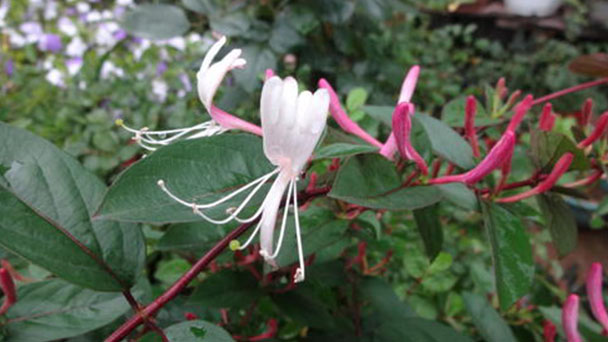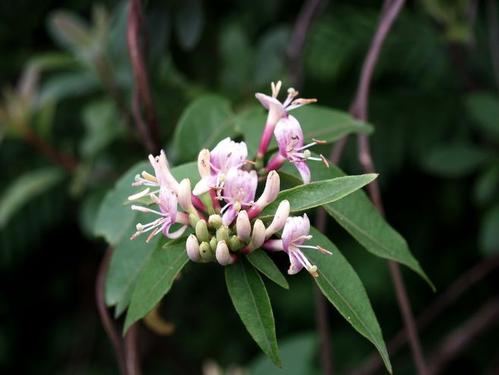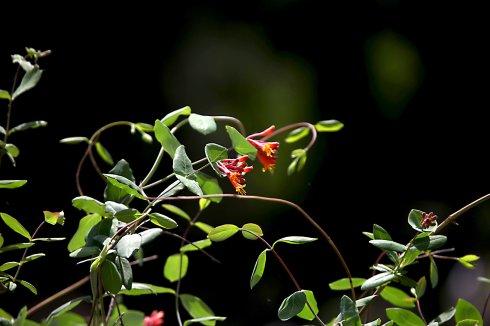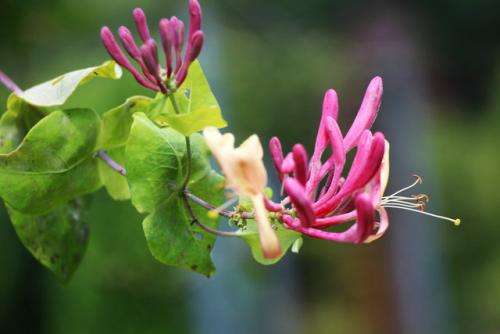Lonicera acuminata (vine honeysuckle) profile
Written by Maggie
Oct 30 2021

Vine honeysuckle (scientific name: Lonicera acuminata), also called fragrant grove honeysuckle, is a plant of the genus Lonicera in the family Honeysuckle. Vine honeysuckle distributes in Taiwan, the Philippines, Burma, the Himalayas and in mainland China, guangxi, yunnan, hunan, fujian, Tibet, hubei, jiangxi, shaanxi, guizhou, gansu, guangdong, anhui, sichuan, zhejiang and other places, growing within 500 meters to 3200 meters, more than growth in valleys, forest kuang, trees, hills, and in thickets, yet by artificial cultivation.
Vine honeysuckle picture

Morphological characteristics of vine honeysuckle
Stems
Vine honeysuckle is deciduous or semi-evergreen vine, young branches, petioles, and pedicels are sparsely or densely, usually curly brownish yellow strigose or strigose, sometimes mixed with spreading strigose and microglandular hairs, or only with flower branchlets apical hairs, or even completely glabrous.
Leaf
Leaves of Vine honeysuckle are thinly leathery to leathery, ovate-rectangular, oblong-lanceolate to strip-lanceolate, 4-8.5 (-14) cm long, apically acuminate to mucronate, basally rounded to subcordates, sometimes broadly cuneate or truncate, sparsely or densely strigose on both surfaces or at least brownish yellowish short strigose on upper midvein, ciliate; Petiole of Vine honeysuckle is 3-5 mm long. (Find more Winter Flowers here.)
Flowers
Vine honeysuckle is bifloral in branchlet apical gathering into subcorymbose or solitary in upper leaf axils of branchlets, total pedicels 4 -- 18 (-23) mm long; Bracts are subulate, shorter or slightly longer than calyx tube, slightly short hispid or glabrous; Bracteoles are broadly ovate or obovate, 2/5-1/3 of calyx tube long, apex obtuse or rounded, sometimes retarginate, ciliate; Calyx tube of Vine honeysuckle is elliptic or urceolate, 2.5-3 mm long, glabrous or shortly strigose, calyx teeth ovate, ovate-lanceolate to narrowly lanceolate or sometimes narrowly triangular, 2/5-1/4 of the length of calyx tube, margin glabrous or sparsely or densely ciliate; Corolla of Vine honeysuckle is yellow-white with red halo, funnel-shaped, 1.5-2.4 cm long, glabrous outside or with spreading or semi-spreading short strigose, sometimes glandular hair, labial, tube 9-12 mm long, as long as or slightly longer than the labellum, with short strigose, cyst is at the base, upper lip erect, lobes round ovate, lower lip inverted; Stamens of Vine honeysuckle are slightly higher than corolla, anthers 4 -- 5 mm long, ca. 1/2 of filaments, filaments short hispid at base; Style is strong except apically.
Fruit
The fruit of vine honeysuckle is bluish-black, oval, 6-7 mm in diameter; Seeds are elliptic to oblong, slightly oblate, 4 -- 4.5 mm long, finely pitted, with a raised ridge at middle of each side.
Vine honeysuckle variation form
Vine honeysuckle has a large range of morphological variation. From our specimens, its morphological variation may have two trends:
(1) The hairs of the Vine honeysuckle body change from dense to thin to completely glabrous. Correlated to this is the tendency of most specimens to have narrow leaves. L. fuchsioides Hemsl. (=L. henryi var. subcoriacea Rehd.) (young shoots hairy only at the apex or completely glabrous, leaves hairy only at the upper midrib), L. alseuosmoides Graebn. (hairs iito, but leaves noticeably narrower and thicker), And hairless vine honeysuckle L. acuminata var. depilata Hsu et H. J. Wang (hairless or nearly hairless in plants) can be used as representatives;
(2) The hairs of the Vine honeysuckle body become dense, often with spreading hard strigose hairs, and the corolla (sometimes the calyx tube) also has hairs. Concordant with this is the change of calyx teeth from wide to narrow, with increased ciliate hairs and sometimes hairs on the outside.L. henryi var. setuligera W. W. Smith and L. giraldii Rehd. (young shoots often spreading pellucid, often sparsely or densely pellucid below leaves, calyx teeth ovate to lanceolate, densely ciliate, calyx tube glabrous or hairy, short pellucid spreading or semi-spreading outside of corolla) may be represented. Specimen of L. giraldii Rehd from Shaanxi and Gansu, often with narrower leaves and a denser coat. After repeated studies, we found that, except for the hairless vine honeysuckle, there was continuous morphological variation between the above representatives and vine honeysuckle, so it was difficult to confirm.

Ecological habits of the vine honeysuckle
Vine honeysuckle is found in forests, open Spaces or thickets on hillsides and valleys, at an altitude of (500-) 1000-3200 m.
The Vine Honeysuckle distribution area
Vine Honeysuckle is produced in Shaanxi, Gansu, Anhui, Zhejiang, Jiangxi, Fujian, Taiwan, Hubei, Hunan, Guangdong, Guangxi, Sichuan, Guizhou, Yunnan, Xizang and other places.
Vine honeysuckle is found in forests, open Spaces or thickets on hillsides and valleys, with an altitude of 1000 ~ 3200m.
The function of Vine Honeysuckle
Vine Honeysuckle's flowers are used in parts of Sichuan Province and Qamdo in Xizang Province as "honeysuckle" to buy medicines.

Read Next:
Best 15 Winter Flowers for Winter Garden
Latest Updated
- Benefits of Bugleweed - 7 Science-backed Health Benefits
- Bugleweed Dangers & Side Effects - Is It Poisonous?
- How to Plant Evergreen Trees - What You Should Know
- When to Plant Evergreens - Grow Guide for Evergreen Trees
- 12 Wonderful Evergreen Shrubs for Your Garden
- 12 Popular Evergreen Plants with Pictures for Beginners
- When And How To Prune A Lilac Bush Like a Pro
- How to Grow & Care for Lilac Vine (Hardenbergia Violacea)
- Japanese Lilac Tree (Syringa Reticulata) Care & Propagation Guide
- Shumard Oak Pros and Cons - What to Know
Popular Articles
- Winter maintenance of Antirrhinum Majus
- How to Grow Terminalia Mantaly Tree
- How to Grow and Care for Crossostephium Chinense
- How to grow Antirrhinum Majus in spring
- Peristeria Elata (Dove Orchid) Profile: Info & Care Guide
- Underwatered Snake Plant (Sansevieria Trifasciata) - Signs And How To Fix
- How to Care for Brazilian Jasmine Plant (Mandevilla Sanderi)
- How to Grow & Care for Graptopetalum Purple Delight in Summer
- Rosa Chinensis (China Rose): Plant Growing & Care Tips
- How to Care for Baby Sun Rose (Aptenia Cordifolia)